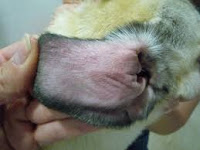Yo soy dueña de un schnauzer toy (que se los presenté en las primeras publicaciones) que es sumamente alérgico, especialmente a los preservantes que encontramos en algunos productos que se venden en los autoservicios; motivo por el cual yo aprendí a elaborar sus piensos. Otto, mi schnauzer, fue diagnosticado desde muy pequeño por lo que pude ayudarlo en su alimentación, hoy increíblemente es un perro que va a cumplir 8 años y aunque su alergia a veces ha tenido sus momentos difíciles, ha podido salir adelante.
Ahora identifiquemos juntos los principales síntomas producidos por las alergias en perros y qué podemos hacer para solucionar el problema.
Primero, debemos saber qué es una alergia: es una respuesta del sistema inmune de nuestro perro frente a un elemento extraño en su organismo denominado Alérgeno. Esta respuesta del sistema inmune es la que causa los síntomas que podemos detectar en nuestro perro, los cuales nos dirán que estamos frente a un tipo de alergia en perros.
Los principales síntomas en perros con algún tipo de alergia son:
· Irritación o enrojecimiento de la piel: Nuestro perro puede presentar problemas en la piel, prácticamente en cualquier parte, aunque especialmente entre los “dedos” y almohadillas de las patas, así como en la parte interna de las orejas que tomaran un tono enrojecido.
· Sarpullidos, erupciones cutáneas y llagas: En cualquier parte, aunque normalmente en abdomen, patas y orejas.
· Inflamación: Pequeños o grandes bultos en el cuerpo de nuestro perro, de forma única o en grupos de pequeñas inflamaciones.
· Sacudidas y/o estornudos: Nuestro perro sacudirá en exceso su cuerpo o cabeza, síntoma de que algo le molesta. La alergia también puede provocar un exceso de estornudos en nuestro perro.
· Vómitos y diarreas: Es completamente normal que nuestro perro tenga vómitos y o desajustes intestinales. En ocasiones acompañados de pérdida de peso y/o apetito, debilidad y desanimo.
· Caída del pelo: Exceso de caída del pelo y aparición de pequeñas o grandes ronchas en su cuerpo.
· Ojos inflamados o enrojecidos: Si la zona que rodea al ojo esta enrojecida o con erupciones, el ojo está inflamado o llora, puede ser un claro síntoma de una alergia.
Estos son algunos síntomas que pueden presentar, pero al igual que nosotros los humanos, cada can puede tener otras manifestaciones de una alergia o cualquier otra enfermedad.
Por lo que no debemos tratar de solucionar el problema nosotros mismos, acudamos a un especialista, quien revisara, analizará y confirmará un diagnóstico para nuestra mascota y recetará los medicamentos adecuados, ya que las alergias por lo general no desaparecen por si solas.
ALLERGIES IN DOGS (Part I)
Many of us have wondered if our dog is allergic or how to know if it is ...
I own a schnauzer toy (which I presented in the first publications) that is extremely allergic, especially to the preservatives found in some products that are sold in the supermarkets. Which is why I learned how to make your feed. Otto, my schnauzer, was diagnosed from an early age so I could help him in his diet. Today he is an incredibly dog that will turn 8 and although his allergy has sometimes difficult moments, he has been able to get ahead.
Now let's identify together the main symptoms produced by allergies in dogs and what we can do to solve the problem.
First of all, we must know what an allergy is: It’s a response of our dog's immune system to a foreign element in his body called Allergen. This response of the immune system is what causes the symptoms that we can detect in our dog, which will tell us that we are facing an allergy in dogs.
The main symptoms in dogs with some type of allergy are:
· Irritation or redness of the skin: Our dog may have skin problems, practically anywhere, but especially between the "fingers" and pads of the legs, as well as in the inner part of the ears that take a reddish tone.
· Inflammation: Small or large lumps in the body of our dog, uniquely or in small inflammation groups.
· Shaking and / or sneezing: Our dog will shake excessively his body or head, a symptom that something bothers him. Allergy can also cause an excess of sneezing in our dog.
· Vomiting and diarrhea: It is completely normal for our dog to have vomiting and / or intestinal maladjustments. Sometimes accompanied by weight loss and / or appetite, weakness and discouragement.
· Hair loss: Excessive hair loss and appearance of small or large hives on your body.
· Swollen or reddened eyes: If the area around the eye is red or rash, the eye is inflamed or crying, it may be a clear symptom of an allergy.
These are some symptoms that may present, but like us humans, each can have other manifestations of an allergy or any other disease.
So we should not try to solve the problem ourselves, we should go to a specialist, who will review, analyze and confirm a diagnosis for our pet and prescribe the appropriate drugs, since allergies usually do not go away on their own.
These are some symptoms that may present, but like us humans, each can have other manifestations of an allergy or any other disease.
So we should not try to solve the problem ourselves, we should go to a specialist, who will review, analyze and confirm a diagnosis for our pet and prescribe the appropriate drugs, since allergies usually do not go away on their own.







No hay comentarios:
Publicar un comentario